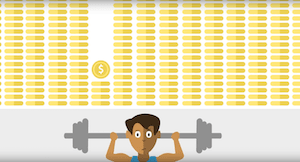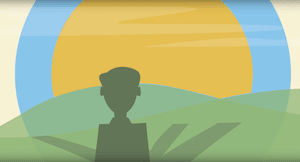
Take it from a full-time creative: There’s a reason people get stuck in ruts of doing things the way we’ve always done them.
Sure, these habits can occasionally be from decades of learning, honing, and perfecting the most efficient and effective ways of doing things. Priorities pile up and new solutions take a backseat. Often, lack of creativity stems from one of two things: burnout or fear of trying something new.
The fear of failure is one challenge, but the burnout piece? Well, the current landscape of education is full of red (and white) flags signaling that burnout has been lurking just over our collective shoulders for awhile now.
But any creative worth their salt will be able to look around and find something to MacGyver into a solution. Right? If this is the expectation you have as a leader, pull up a chair to this pile of smoldering ash and let’s chat.
Problem 1: Creativity takes miracles
Have fun storming the castle!
Do you think they can do it?
It would take a miracle.
Billy Crystal and Carol Kane in heavy facial prosthetics for The Princess Bride aside, we ask our teams of support staff and teachers to make miracles every day. (You can read more about that from actual teachers here.) A miracle takes a few things, but most of all it takes time (more on that later) and money.

This ability to create something new out of nothing much (sometimes called alchemy, magic, or creativity) is valuable, and everyone wants it. Leaders want teams full of creative people but can lose sight of what it looks like to be creative—warts and all—especially among long lists of other demands and the data-driven daily grind (although data and numbers shine in their own right).
Solution? Build a high-performing team laser-focused on your mission and follow their lead. You’ll need a leadership team willing to communicate clearly, build trust, and identify those who are capable of leading from within. Jump ahead of the highly competitive job market and build an unshakable brand true to your mission and roots.
Problem 2: Creativity requires brainpower
All day long we’re transforming sleep, caffeine, and hopefully a vegetable every once in a while into work, service, and relationships we build with others. What’s most important for people to dedicate energy to? In a school setting, culture and connection reigns supreme. Vigilance for security and the ability to spot a threat, physical or digital. The wherewithal to pinpoint a need and meet it so learning can take place.It all takes a superhuman amount of energy! What can we offload or automate to make our teammates more available to create solutions only humans can create? Relationships, connections, problem solving: no computer can be relied on to do these tasks for us (particularly extremes and outliers).
However, another statistical truth: No one can give every task 100%. And while some of the messier among us may not gravitate toward spotless record retention or turn in lesson plans on time, what are their strengths? Do students gravitate toward them? Do they have a way with the wayward? Play to strengths and ditch the one-size-fits-all to find a fit for every creative leader.
Solution? Automate, automate, automate! Especially data. The more we automate, the more we relieve working memory for building relationships and coaching students—and the more accurate our data is. Make machines do the work they’re made for, while teachers do the same. Wins all around and no sacrificing accuracy.
Problem 3: Creativity requires vulnerability
Have a maverick who’s always toeing the line and gets grief about it? They’re learning not to take risks or be creative.Vulnerability is not something any leader receives on-demand. Culture, coaching, and the slow growth of trust over time helps vulnerability emerge, and with it blooms the willingness to fail just in case you fly.
Solution? Create psychological safety. Put your leadership cred to the highest use only for matters of strategic importance (h/t Jocko Willink and Leif Babin). Pick your battles. (No, no. Fewer battles than that. Put some battles back.)
Problem 4: Creativity requires feedback
Feedback is a fickle thing. It can be constructive or overly critical. It can fan the fire or squash the spark. Learning to give successful feedback is tricky enough but learning to take feedback gracefully is a skill we can all enjoy.Creativity is a team sport. I have it on good authority from a lifeling creative: one of the better ways to improve at it is to surround yourself with creative people. Observe them flexing their creative muscle.
Solution? Invest in your ability to give constructive feedback, and in your team’s ability to accept feedback gracefully and actionably. Get out of your comfort zone, take some chances, make mistakes, and get messy (to paraphrase the queen of magical teaching herself, Ms. Frizzle).
Problem 5: Creativity requires grace
It’s an ebb and flow. No one can be creative on command, and no one’s creative output will be all build all the time. Ups and downs in creativity can put people in tricky situations. Which do you want more: people pushing the limits to be the best they can be, or flawless robots who elicit zero negative feedback but never achieve anything more than the status quo?The pandemic and remote learning challenges forced districts to think outside the box, and those who were comfortable with using creative problem solving performed best. But it shouldn't take a once-in-a-lifetime global emergency to spur creativity. Proactive creativity might feel like fixing something that isn't broken. The truth is there's no better time to improve than when you're already doing well. It may even make solving a crisis that much more comfortable.
Solution? Figure out your limits and expectations, then communicate them. Be open to creative solutions, even if it isn't the way you've always done it. Find a way to make creativity part of your team's regular routine.
Problem 6: Creativity takes time
One of the squishiest parts of deep creativity is its apparently idle time during which we are nurturing a small idea seed until it’s ready to burst Athena-like from our heads, completely transformed. This flow state frees up our deepest consciousness to gnaw at a problem until our brains can untangle it—but it’s elusive. “There’s a stereotype that writers and creatives can enter the zone at will—that we sit down at our laptops and the world melts away,” writes science journalist and author Alice Robb.
Instead of achieving flow on command, creatives can enter through its secret passageway: doing something fun, often slightly physical, with no resemblance to mundane, daily tasks. When creatives absolutely must produce on a tight deadline, which must happen sometimes (procrastination nation represent), leaders can help get the ball rolling in a couple tried-and-true ways.
Solution? Set deadlines thoughtfully. Respect contract hours. Create ways to achieve rest + flow. When your team really struggles to get creative juices flowing, send them out for a 10-minute walk, have them put on their favorite playlist, and then try a Pomodoro session to get something produced the team can iterate from. A blank page is daunting, but a crappy first draft is editable.
When it comes right down to it, humans are creative people almost 24/7. With the prime conditions to allow creativity to bloom freely, imagine what your talented teams could create.

Follow-up resource: Design thinking for admins
Wondering how to think outside the box? Here’s a guide to get started.WHAT'S NEXT FOR YOUR EDTECH? The right combo of tools & support retains staff and serves students better. We'd love to help. Visit skyward.com/get-started to learn more.

|
Erin Werra Blogger, Researcher, and Edvocate |
Erin Werra is a content writer and strategist at Skyward’s Advancing K12 blog. Her writing about K12 edtech, data, security, social-emotional learning, and leadership has appeared in THE Journal, District Administration, eSchool News, and more. She enjoys puzzling over details to make K12 edtech info accessible for all. Outside of edtech, she’s waxing poetic about motherhood, personality traits, and self-growth.




